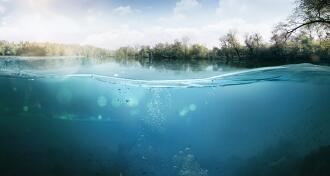North Carolina is prioritizing the marine fisheries and oyster industries to provide growth opportunities for non-urban coastal communities. Activities in the North Carolina House of Representatives and Senate during the last regular session included increases in:
- Budget allocations for oyster sanctuaries;
- Funds to explore expanding the economic stability and performance of the oyster industry; and,
- Leasing opportunities available for fisheries.
Similarly, the new legislation envisions partnership with federal agencies for the study, management, and protection of key species of economic value.
Oysters
There is no lack of demand for oysters in North Carolina. North Carolina's tourism industry provides a steady stream of oyster lovers who find the bivalves an excellent pairing with craft beer and the locavore farm-to-table food scene.
As filter feeders, oysters also improve the environment in which they live because each oyster filters approximately 50 gallons of water daily, consumes phytoplankton, and removes other substances like dirt and nitrogen, leaving the water cleaner. Oysters also protect shorelines from erosion and provide habitat for coastal wildlife. North Carolina already has high quality coastal waters with the necessary salinity levels for oysters to thrive, so it's time for greater efforts to increase supply.
History of Oyster Harvest Rules
North Carolina has long recognized the economic, employment, and ecological benefits of shellfish cultivation. As early as the mid-1800s, the General Assembly passed laws governing the harvesting of oysters, such as setting a commercial oyster season (September-April) and providing that the public water bottom was available for private use by North Carolina residents for oyster cultivation.
Following the Civil War and after they had depleted the Chesapeake Bay oyster beds, oyster houses from Maryland and Virginia came south and brought with them modern methods of harvesting such as commercial dredging. Fears that North Carolina's oyster beds would suffer the same depletion fate led to laws prohibiting harvest by non-residents.
In the early twentieth century, the General Assembly passed laws reinstating the commercial dredging season and defining areas for, and limits on, oyster harvesting. Throughout the twentieth century however, oyster landings decreased as harvest limits remained. As a result, North Carolina has lagged well behind Virginia and Maryland for oyster production.
Increased Leasing Opportunities
In North Carolina, oyster harvesting is limited to those who have a lease for a "tract of water." North Carolina General Statutes Chapter 113, Article 16 and the related regulations authorize the North Carolina Department of Environmental Quality, Division of Marine Fisheries ("DMF") to administer tracts of water leasing and to collect related annual fees.
Oyster harvesters cannot own a tract of navigable water or the land under it outright because North Carolina's long-standing public trust doctrine holds that no person can own them or the beachfront sand adjacent to them. Rather, they are held in trust by the state government for the use and benefit of the public in general. Leases allow individuals to restrict access to the leased area, including the area of bottom land leased and the superjacent vertical water column above, but each lessee needs to make beneficial use of the leased water and bottom land, such as through shellfish aquaculture.
The DMF lease application is fairly lengthy, and includes mapping requirements. Some sites may require surveys. Applicants must be North Carolina residents. No applicant can lease more than 50 acres collectively in any capacity, as an individual or member of a corporate entity. Applications are subject to public hearing. Once approved, leases are valid for 10 years and can be renewed. Leases are also subject to inspection and regulation by government agencies and can be terminated for various reasons, including the failure to pay annual rent.
Shoring Up the Oyster Population
Recently, renewed efforts by private industry and environmental groups to shore up the oyster population are resulting in the best combination of agribusiness and environmental stewardship. The biggest boon for oyster harvesting is North Carolina's willingness to fund efforts to restore the oyster industry. In the compromise budget bill that was signed by Governor Cooper during the regular session, the General Assembly approved continued funding for the oyster sanctuary rehabilitation program, funded cultch planting (seeding new oyster stock), and funded the Oyster Study and Shellfish Mariculture Plan ("Plan").
Under the Plan, the DMF can contract with the North Carolina Sea Grant to study the state's shellfish industry, make recommendations on how to ecologically restore and achieve economic stability of the shellfish industry, and develop a Shellfish Mariculture Plan. It has been estimated by some studies that for the dollars invested in oyster habitat restoration the resulting jobs, revenue, and clean water generated can restore coastal communities as well. Such funding may provide the improvements to make the industry competitive.
Partnership with Federal Agencies
Another historic limit on oyster production has been policy set by the United States Army Corps of Engineers ("Corps"), which has jurisdiction over certain waters in North Carolina. For years the Corps banned shellfish leases in some areas in order to protect submerged aquatic vegetation which improves water quality and fish habitat and is protected by the Corps and the North Carolina Coastal Resources Commission regulations. Revisions to the Corps' Nationwide Permit 48 in March of this year lifted some of those restrictions and may open up new areas to shellfish leasing in conjunction with the State's new initiatives.
Marine Aquaculture in General
The oyster industry was not alone in capturing the recent support of the General Assembly. Although oysters and other shellfish hold the pole position in terms of marine aquaculture, the deck now is set for other species to find their way into the stream of commerce. Senate Bill 410, which became Session Law 2017-190, added a new Article 16A to General Statute Chapter 113 to establish a program for leasing public bottom land and superadjacent water columns for marine aquaculture to promote increased seafood production.
Conclusion
These legislative efforts are a clear attempt to marry economic growth and opportunity with the responsible management of our natural resources. With any luck, North Carolina will join the ranks of the states that have successfully joined aquaculture and environmental stewardship.









